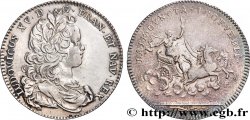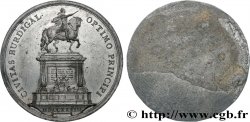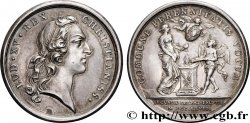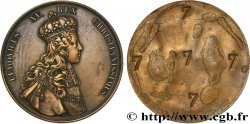E-auction 328-244726 - fme_445269 - LOUIS XV DIT LE BIEN AIMÉ Médaille de la Monnaie de Paris, refrappe
Usted debe firmar y ser un comprador aprobado para pujar, Inicia sesión para pujar. Las cuentas están sujetas a la aprobación y el proceso de aprobación se alcanzan dentro de las 48 horas. No espere hasta el día en una venta se cierra el registro.Al hacer una oferta en este artículo usted está firmando un contrato jurídicamente vinculante para comprar este artículo y haga clic en «oferta» constituye una aceptación de los términos de uso de e-auctions de cgb.fr.
La subasta debe ser colocado en euros enteros cantidades venta only.The se cerrará en el momento en la descripción del artículo, no se ejecutarán las ofertas recibidas en el sitio después de la hora de cierre. Veces Transmition pueden variar y las ofertas pueden ser rechazadas si espera a los últimos segundos. Para más información envie el FAQ.
SIN GASTOS PARA LOS COMPRADORES.
SIN GASTOS PARA LOS COMPRADORES.
| Valoración : | 90 € |
| Precio : | 16 € |
| Oferta más alta : | 17 € |
| Fecha de fin de la venta : | 29 julio 2019 18:17:00 |
| participantes : | 3 participantes |
Tipo : Médaille de la Monnaie de Paris, refrappe
Fecha: 1770
Nombre del taller / ciudad: Monnaie de Paris
Metal: bronce
Diámetro: 42 mm
Eje de acuñación: 12 h.
Acuñador ROËTTIERS Charles Norbert (1720-1772)
Peso: 36,6 g.
Canto: lisse + corne BRONZE
Cuño: corne BRONZE
Comentarios sobre el estado de conservación:
Exemplaire percé à 12 heures et nettoyé
Anverso
Titulatura del anverso: LUD. XV. REX. - CHRISTIANISS.
Descripción del anverso: Tête laurée de Louis XV à droite.
Reverso
Titulatura del reverso: AURO ARGENTO AERI FLANDO FERIUNDO // AEDES AEDIFICATAE / MDCCLXX.
Descripción del reverso: Vue de la Monnaie depuis la Seine.
Comentario
En 1765, Jacques-Denis Antoine fut préféré aux architectes Étienne-Louis Boullée et François Dominique Barreau de Chefdeville pour la construction de ce nouveau bâtiment de style néoclassique. L'abbé Jean Delagrive propose de réaliser le projet sur les quais de la Seine, à l'emplacement de l'ancien hôtel de Conti, qui avait été racheté par la Ville de Paris pour construire un nouvel hôtel de ville. Un arrêt du Conseil retint définitivement ce site auquel Antoine adapta ses plans, un quadrilatère de 1 hectare composé de plusieurs cours. Le site n'était pas encore très bien desservi, mais l'emplacement était historique et les perspectives urbanistiques valorisantes.
La première pierre fut posée par l'abbé Terray le 30 avril 1771. La façade sur le quai, longue de 117 m, fut achevée en 1773 et le gros œuvre, ainsi que l'essentiel du décor, en 1775. Cet édifice, très admiré, valut à Antoine d'entrer en 1776 à l'Académie royale d'architecture. Certains critiquèrent toutefois la façade sur le quai, jugée d'une magnificence peu en accord avec le caractère d'une « manufacture ».
In 1765, Jacques-Denis Antoine was chosen over architects Étienne-Louis Boullée and François Dominique Barreau de Chefdeville for the construction of this new neoclassical-style building. Abbé Jean Delagrive proposed carrying out the project on the banks of the Seine, on the site of the former Hôtel de Conti, which had been purchased by the City of Paris to build a new town hall. A Council decree definitively selected this site, to which Antoine adapted his plans: a 1-hectare quadrilateral composed of several courtyards. The site was not yet very well served, but the location was historic and the urban perspectives were attractive. The first stone was laid by Abbot Terray on April 30, 1771. The 117 m long façade on the quay was completed in 1773 and the main work, as well as most of the decoration, in 1775. This much admired building earned Antoine entry into the Royal Academy of Architecture in 1776. However, some criticized the façade on the quay, which was considered to be of a magnificence that was not in keeping with the character of a \\\"manufactory\\\".
La première pierre fut posée par l'abbé Terray le 30 avril 1771. La façade sur le quai, longue de 117 m, fut achevée en 1773 et le gros œuvre, ainsi que l'essentiel du décor, en 1775. Cet édifice, très admiré, valut à Antoine d'entrer en 1776 à l'Académie royale d'architecture. Certains critiquèrent toutefois la façade sur le quai, jugée d'une magnificence peu en accord avec le caractère d'une « manufacture ».
In 1765, Jacques-Denis Antoine was chosen over architects Étienne-Louis Boullée and François Dominique Barreau de Chefdeville for the construction of this new neoclassical-style building. Abbé Jean Delagrive proposed carrying out the project on the banks of the Seine, on the site of the former Hôtel de Conti, which had been purchased by the City of Paris to build a new town hall. A Council decree definitively selected this site, to which Antoine adapted his plans: a 1-hectare quadrilateral composed of several courtyards. The site was not yet very well served, but the location was historic and the urban perspectives were attractive. The first stone was laid by Abbot Terray on April 30, 1771. The 117 m long façade on the quay was completed in 1773 and the main work, as well as most of the decoration, in 1775. This much admired building earned Antoine entry into the Royal Academy of Architecture in 1776. However, some criticized the façade on the quay, which was considered to be of a magnificence that was not in keeping with the character of a \\\"manufactory\\\".








 Informar de un error
Informar de un error Imprimir la página
Imprimir la página Comparte mi selección
Comparte mi selección Haz una pregunta
Haz una pregunta Consignar / vender
Consignar / vender
 Descriptivo
Descriptivo










